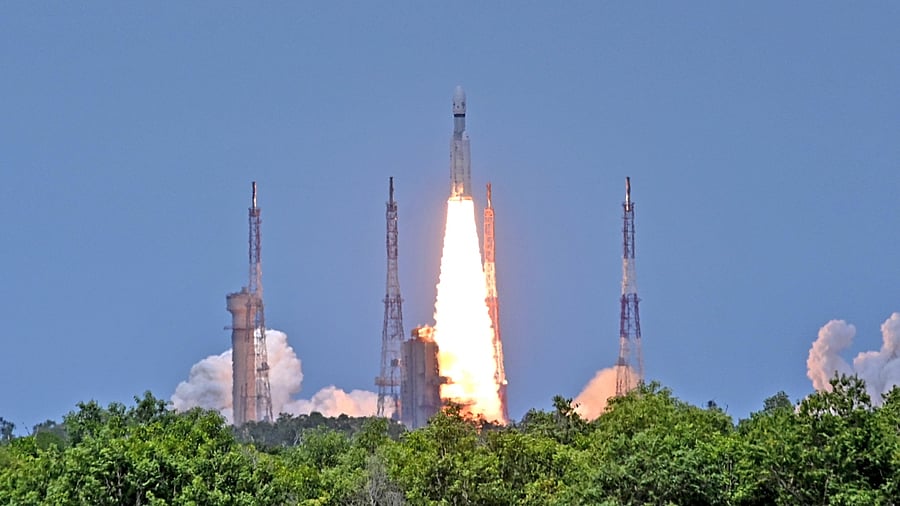
Carrying a billion dreams, Chandrayaan-3, India’s third unmanned lunar mission, on Friday began its 40-day long journey to the moon following a successful blast-off from the second launchpad of the Satish Dhawan Space Centre (SDSC) here.
If all goes well, the spacecraft will make a soft and safe landing on the south polar region of the moon at 5.47 pm on August 23. Through its journey, Rs 600 crore Chandrayaan-3 will be monitored and controlled by scientists of the Indian Space Research Organisation (ISRO) at ISTRAC Centre in Bengaluru.
In the event of a successful landing, India will join the elite club of US, Russia, and China, who have achieved the feat in the past, providing much needed confidence to the ISRO to go for more lunar missions and fast-track the ambitious manned space mission, Gaganyaan.
The LVM3-M4 rocket, known as ISRO’s ‘Fat Boy’ for its heavy lift capability, launched Chandrayaan-3 at 2.35 pm as planned, leaving a trail of thick orange smoke. Sixteen minutes later, the launch vehicle placed the spacecraft into its intended orbit, and it would orbit the earth for six times in an elliptical cycle with 170 km closest and 36,500 km farthest from earth moving towards the lunar orbit.
“Congratulations India. Chandrayaan-3 has started its journey towards the moon. LVM3-M4 has put the craft into the precise orbit. We wish the spacecraft all the very best for further orbit raising maneuvers and its further journey towards the moon,” ISRO Chairman S Somnath said.
Scientists said the precise goal is to make a soft and safe landing on the south polar region of the moon, which is still unexplored. The region is of intense interest due to the presence of many permanently shadowed craters which could contain water ice and precious minerals, and the spacecraft is expected to make several discoveries.
Somnath said several changes including reducing the number of engines from five to four, expanding the landing area, installation of a new software system are some of the improvements that ISRO made in Chandrayaan-3 after Chandrayaan-2 failed to make a soft landing on the moon in 2019 due to a problem in the onboard system and propulsion system.
Strengthening the lander’s legs, and conduct of special tests like Integrated Cold and Integrated Hot tests and Lander Leg mechanism performance are other measures taken to ensure that the spacecraft lands on the lunar surface.
Chandrayaan-3 Project Director P Veeramuthuvel said the spacecraft’s health parameters, including power generation in propulsion module and lander module, were normal.
“We have several critical phases to monitor before the spacecraft makes a soft landing (near the moon). They are earth bound maneuvers, insertion into the lunar orbit, separation of the lander, a set of deboost maneuvers and finally the power descent phase for soft landing of the moon,” he said.
Somnath said the infusion of Chandrayaan-3 into the lunar orbit is planned from August 1. “The soft landing on lunar surface has been planned for 5.47 pm on August 23,” Somnath added.
Billed as a follow-up mission to Chandrayaan-2, Chandrayaan-3 will seek to demonstrate end-to-end landing and roving capabilities.
The Chandrayaan-3 lander carrying a rover within it will be carried into an orbit around the moon by the propulsion module. A little later, the lander will separate from that module and will attempt to make a soft landing in the south polar region of the moon, which is of intense interest as it has many permanently shadowed craters which could contain water ice and precious minerals.
India’s first unmanned mission, Chandrayaan-1, which took off on October 22, 2008, demonstrated the country’s ability to reach the surface of the moon and discover water on the lunar surface, while the Chandrayaan-2 mission’s aim was to make a soft landing on the moon.
The Chandrayaan-3 mission is yet another attempt to achieve the goal with the help of a rover. The spacecraft, according to officials, will have four payloads which will study moon quakes, as to how the surface of the moon allows heat to flow through it, the plasma environment near the moon surface, and enable scientists to measure the distance between earth and moon “very accurately.”
The two rover payloads study composition of the moon’s surface using X-rays and LASER, while the propulsion module payload will explore the Spectro-polarimetric signatures of the habitable planet, Earth. The mission is divided into three phases -- Earth Centric, Lunar Transfer, and Moon Centric.
The work on Chandrayaan-3 began just a few months after the failure of Chandrayaan-2, but the Covid-19 pandemic and the subsequent lockdown delayed ISRO’s plans. By demonstrating its capabilities to soft land on the moon, the ISRO is also hoping to expand its business as it is already launching private satellites from Sriharikota.
